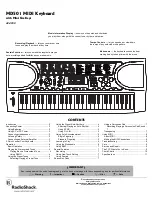
Triple Modular Processing
Editing Triples
12-7
When Layer 1 or 2 of a triple uses a keymap containing ROM samples (or edited ROM samples),
and you want the samples to sound relatively normal, you’ll generally need to do two things:
•
Include an AMP block in the layer
•
Use the layer’s default (natural) amplitude envelope
The AMP block ensures that the layer’s amplitude envelope gets applied to the layer. The
natural amplitude envelope ensures that the decompression information gets applied to the
layer (user-de
fi
ned envelopes contain only Attack-Decay-Release information, and no
decompression information). Of course, you might like the way a layer sounds
without
the AMP
block, or with a user-de
fi
ned amplitude envelope.
To check whether a layer’s keymap uses its default (natural) amplitude envelope or a user-
de
fi
ned amplitude envelope, go to the AMPENV page for that layer. If the only visible
parameter is Mode, with a value of
Natural
, the layer is using its natural amplitude envelope. If
you see a lot of parameters like Att1, Dec1, and Rel1, the layer is using a user-de
fi
ned amplitude
envelope. To revert to the natural amplitude envelope, select the word
User
, and change it to
Natural
by turning the Alpha Wheel one click in either direction.
Input Locations
We mentioned that Layer 2’s amplitude envelope may or may not affect the sound of Layer 1—it
depends on the location of Layer 2’s AMP block relative to the input(s) from Layer 1.
Figure 12-3 shows the algorithm for Layer 2 of a triple. The input point from Layer 1 is in the
third DSP block (F2, a crossfade mixer in this case), as indicated by the arrow entering the
F2 block from above the algorithm. Layer 2’s AMP block (F1, which is highlighted) is
before
the
input point, which means that the amplitude envelope for Layer 2 gets applied
before
the signal
from Layer 1 joins the signal from Layer 2. Consequently the amplitude envelope of Layer 2
affects only Layer 2, and doesn’t affect the sound of Layer 1.
EditProg:ALG|||||||||||||||<>LyrT2:2/3||
||||||||||||||||||||||||||||||||||||||||
Algorithm:65|||||[Triple,|layer|2|of|3]|
||||||||||||||||
6
|||||||||||||||||||||||
qwwwwwwtqWWERWWT7wwerwwtqwwerwwtqwwerwt
|
d
PITCH|
gk
AMP|||
I;
XFADE|
gk
NONE||
gk
ALPAS
j
|
cvvvvvVbcvvvvVvbnvvvVvvbcvvVvvvbcvVvvvm|
<more|
|
F1|AMP
|
F2|XFD
|
F3|OFF
|
F4|FRQ
|
more>
|
Figure 12-3
AMP block before input point
Figure 12-4 shows the same algorithm, with one change: the AMP block is now in F3
(highlighted),
after
the input point of Layer 2. This means that the amplitude envelope for
Содержание K2661
Страница 18: ...2 4 LFOs LFO Shapes...
Страница 34: ...3 16 DSP Algorithms...
Страница 54: ...5 4 MIDI Note Numbers Note Numbers for Percussion Keymaps...
Страница 72: ...7 10 System Exclusive Protocol K2661 System Exclusive Implementation...
Страница 82: ...9 4 Upgrading Sample Memory Choosing and Installing a SIMM for K2661 Sample Memory...
Страница 334: ...10 252 KDFX Reference KDFX Algorithm Specifications...
Страница 340: ...11 6 Glossary...
Страница 382: ...12 42 Triple Modular Processing Alphanumeric Buttonpad Entries for DSP Functions...
Страница 392: ...B 6 SysEx Control of KDFX MSB and LSB...
Страница 442: ...D 20 Contemporary ROM Block Objects Controller Assignments Contemporary ROM Block...
Страница 490: ...H 12 General MIDI Standard Mode Controller Assignments...
Страница 492: ...I 2 Live Mode Objects Live Mode Programs...
Страница 498: ...K2661 Musician s Reference Index...
Страница 500: ......
















































